 |
 |
Large
Igneous Provinces, Mantle Plumes and Uplift:
A Case Study from the Dhanjori Formation,
India
|
|
| |
Introduction
Significant pre-volcanic
uplift of the lithosphere is one of the expected consequences
of mantle plume upwelling (Campbell & Griffiths,
1990; Farnetani & Richards, 1994). Many
major mafic/ultramafic lavas have been attributed
to mantle plumes that are expected to produce crustal
uplift (doming) preceding the major phase of volcanism.
Such pre-volcanic uplift would have significant consequences
on the regional sedimentation pattern. These include
-
progressive
palaeogeographic shallowing and thinning of strata,
-
the abrupt
appearance of erosional unconformities (“sequence
boundaries” in sequence stratigraphic terminology),
and
-
radial drainage
and palaeocurrent patterns.
Subsequent erosion may remove
much of the volcano-sedimentary record of domal uplift.
However, sedimentologists can identify progressive
shallowing of palaeogeography prior to volcanism and
distinctive palaeocurrent patterns if these exist,
and this may provide constraints on plume interpretations
of the volcanic episode. So far, the emphasis in large
igneous province (LIP) research has been on geochemistry,
geochronology, petrology, geophysics and physical
volcanology. However, the sedimentology and stratigraphy
of adjoining lithological units are of paramount importance
in constraining the sequence, timing and magnitude
of vertical motions accompanying volcanism and should
not be neglected (Rainbird, 1993; Williams
& Gostin, 2000; Rainbird & Ernst,
2001; He
et al.,
2003).
LIPs may or may not be related to mantle
plumes. It is difficult to defend a LIP–mantle
plume connection where pre-volcanic lithospheric uplift
is absent. This is particularly true for continental
flood basalts (CFB; see Czamanske et al.,
1998; Sheth, 1999; also the Siberia
page and the Deccan page).
Also, not all oceanic LIPs are associated with pre-volcanic
crustal uplift (e.g., Neal et al.,
1997). LIPs without evidence for pre-volcanic uplift
invite reconsideration of both the plume-impact and
the plume-incubation models (Sheth, 1999).
Recently, He
et al.
(2003) reported rapid, kilometer-scale crustal
doming prior to the eruption of the Emeishan flood
basalts, a LIP that formed close to the Permo-Triassic
boundary in southwest China. This postualted plume-induced
uplift was correlated with the sudden change from
carbonate-platform to terrestrial-clastic facies in
the western Yangtze Craton at the transition between
the Middle and Upper Permian. He
et al.
(2003) relied on local published accounts not
easily accessible to international readers on the
generalized Permian stratigraphy and inferred palaeogeography
(He
et al.,
2003; their Figure 2) without presenting any field
photographs. However, their stratigraphic-thickness
data (He
et al.,
2003; their Figure 3) clearly indicates crustal
doming. Nevertheless, He
et al.
(2003) do not comment on any associated change
in palaeocurrent pattern, which is an expected consequence
since the Emeishan flood basalts are overlain by terrestrial
sedimentary rocks.
An important question related to plume
models for LIPs is whether uplift and extensional
deformation precede magmatism in the manner predicted
by experimental and numerical models (Griffiths
& Campbell, 1991; Farnetani & Richards,
1994; He
et al.,
2003). A plume-induced radial drainage/palaeocurrent
pattern (Cox, 1989; Kent, 1991)
is expected in both terrestrial and marine settings.
Cox (1989) reported such a drainage pattern
on peninsular India and postulated that it was a consequence
of pre-volcanic uplift prior to Deccan volcanism.
However, the drainage pattern of peninsular India
is much older than the Deccan volcanism (Sheth,
2003a,b). Also, the uplift of the Western Ghats
is recent and ongoing. If this is the case, a plume
model for Deccan volcanism is not supported (Sheth,
2003a,b).
The sedimentological and stratigraphic
criteria proposed for tracing LIP-plume connections
are somewhat generalized, and will not all be useful
at a given location. For example, progressive shallowing
of palaeogeography as a consequence of plume-induced
lithospheric uplift should be clear in a marine depositional
setting (e.g., in the transition from deep
to shallow marine, or marine to terrestrial palaeogeography;
see Richards et al., 1991; Rainbird,
1993; Rainbird & Ernst, 2001; He
et al.,
2003 for various case studies). In a continental
depositional setting, such evidence is less likely
to be found, however. This is because the depositional
surface is already well above mean sea level (the
base level of erosion) and its preservation potential
is small. Unlike the case of marine depositional settings,
an erosional unconformity/sequence boundary will thus
not develop because the depositional surface is already
subaerially exposed.
In
addition, various soft sediment/pre-lithification
deformation structures are expected within underlying
sediments that have suffered uplift, irrespective
of palaeogeographic setting. This is because
mass-flow processes would have operated because
of large changes in palaeoslope. Rainbird
(1993) documented clear evidence of penecontemporaneous
volcanism from the sediment-lava contact from
the Neoproterozoic Shaler Group, Victoria Island,
Canada (Figure 1). Careful sedimentological
investigations thus have the potential to provide
valuable insights relevant to evaluating possible
plume-LIP genetic linkages, that cannot be investigated
by other means. |
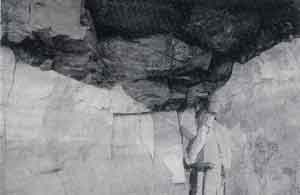
Figure 1: Cross-sectional
view of longitudinal projections developed at
the interface between a gabbro sill and quartz-arenite
of the Kuujjua Formation, Canyon Creek area
(Canada). The base of the silll has loaded down
into the underlying sediment, indicating that
the sand was soft when the sill was injected
(from Rainbird, 1998; Figure 8c). |
The
Dhanjori Formation
There is a strong correlation between
CFB provinces and cratonic margins (Anderson,
1994; King & Anderson, 1995). Also a
majority of CFBs have apparently erupted through deep
rifts containing thick sedimentary sequences (e.g.,
Sheth, 1999). Best studied are Phanerozoic
CFB, although mantle plumes have been invoked to explain
Precambrian mafic volcanism as well. Recently I studied
the Late Palaeoproterozoic siliciclastic Dhanjori
Formation, Singhbhum province, India (Mazumder,
2002; Mazumder
& Sarkar,
2004; Fig. 2a,b). The Dhanjori Formation comprises
Late Palaeoproterozoic terrestrial (alluvial fan-fluvial)
continental deposits along with interbedded mafic
and ultramafic (minor felsic) magmatic rocks formed
in an intracontinental rift setting (Mazumder
& Sarkar,
2004). The magmatic episode is unrelated to normal
plate boundary processes (Mazumder
& Sarkar,
2004) and thus the magmatic component of the Dhanjori
Formation represents a LIP (Coffin & Eldholm,
1994; Prokoph et al., 2004).
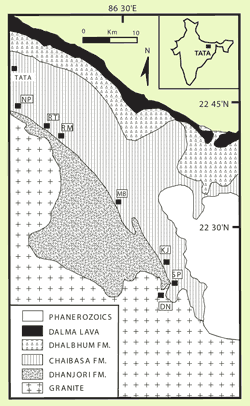
Figure 2a: Simplified geological
map of the Dhanjori basin study locations:
DN, Dongadaha; KJ, Khejurdari; SP, Singpura;
MB, Mosaboni; RM, Rakha Mines; RK, Rukmini
Temple (Jadugorah); NP, Narwa Pahar. Nearest
city (Tata) shown on the map of India.
|
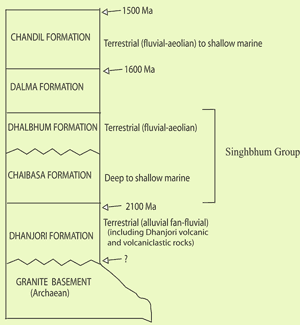
Figure 2b: Proterozoic stratigraphic
succession of the Singhbhum crustal province,
India (after Mazumder,
2003).
|
The Dhanjori Formation overlies Archaean
Singhbhum Granite and represents terrestrial (alluvial
fan-fluvial) deposits interbedded with mafic-ultramafic
and minor felsic volcanic and volcaniclastic rocks.
It is overlain by the deep-to-shallow marine Chaibasa
Formation (Bose
et al.,
1997; Mazumder
et al.,
2000; Mazumder
& Arima, 2005; Mazumder,
2004; Mazumder,
2005a; Mazumder,
2005b; Mazumder
et al., 2006; Figures 2a,b). Cooling of the voluminous
Archaean Singhbhum granite possibly induced isostatic
readjustment. The associated extensional regime and
deep-seated fractures controlled the formation of
the Proterozoic Dhanjori basin (Mazumder,
2002; Mazumder
& Sarkar,
2004; Roy et al., 2002).
The Dhanjori Formation comprises two
members: the lower member includes phyllites, quartzites
and thin conglomerates, whereas the upper member has
volcanic and volcaniclastic rocks along with some
quartzites and phyllites (Figure 3). Basin tilting
and volcanic eruption intervened and resulted in the
second phase of Dhanjori sedimentation, although the
general fluvial depositional setting remained unaltered.
The different palaeocurrent trends displayed by the
two members are a consequence of fluvial response
to basin tilting. The volcanic and volcaniclastic
rocks might have blocked river courses resulting in
short-lived lacustrine deposition (Mazumder
& Sarkar ,
2004).
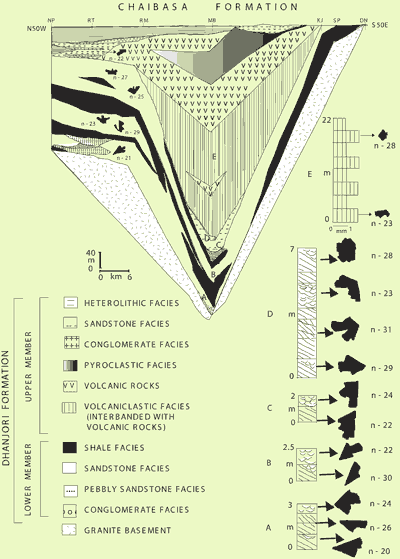
Figure 3: Lateral
and vertical facies transition during Dhanjori
sedimentation. Short sections showing interrelationship
between various sandstone facies and temporal
change in palaeocurrent direction are also shown
(after Mazumder
& Sarkar, 2004; their Figure 2; n represents
number of palaeocurrent measurements). Study
locations are marked in Figure 2a. Lithofacies
constituents of the lower and upper members
of the Dhanjori Formation are also marked. See
Mazumder
& Sarkar (2004) for detailed sedimentary
facies analysis. Click on figure for enlargement. |
Dhanjori volcanism took place
in an intracontinental rift setting as is
evident from the interbedded, compositionally
immature terrestrial deposits (Mazumder
& Sarkar,
2004; Figures 4a,b). Confinement of the
volcanic and volcaniclastic rocks within the
upper member (Figure 3) implies that initiation
of rifting was not a consequence of convective
upwelling in the mantle. The presence of basalts
(Figure 5), including some ultramafics, within
the upper member implies subsequent upwelling
of mantle materials and decompressional melting
following crustal extension. Gupta et
al. (1985) (summarized in Mazumder
& Sarkar,
2004 and references therein) reported
komatiitic rocks from the Dhanjori Formation,
but typical komatiites with convincing chemistry
and texture are absent. Although interbedded
volcanics and volcaniclastics at different
stratigraphic levels within the upper member
indicate episodic volcanic eruption during
sedimentation, evidence for pre-volcanic uplift
are lacking and so is a radial palaeocurrent
pattern (Cox, 1989; Kent,
1991). If Dhanjori volcanism is related to
a mantle plume, then the consequences of this
plume are not seen in the sedimentological
record. Alternatively, the volcanism may simply
represent a CFB unrelated to a mantle plume.
|
| 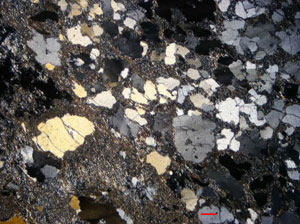
Figure 4a:
Poorly sorted and texturally immature Dhanjori
sandstone (red bar length 0.2 mm). Note the
dominance of angular quartz and rock fragments. |
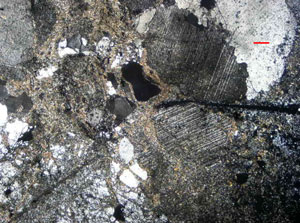
Figure 4b:
Coarse-grained, feldspar-rich Dhanjori sandstone
(red bar length 0.2 mm). |
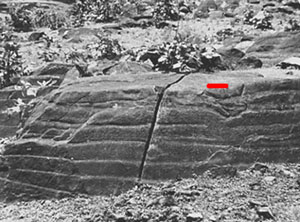
Figure 5: Flow banding within
Dhanjori basalt (bar length 14 cm).
|
Final
remarks
The claim that the sedimentary
record provides independent supporting evidence
for mantle plume influence on the generation
of LIPs, is not always true (see also pages
on Siberia, the
Ontong Java Plateau
and Ontong Java Plateau
Impact theory). The genetic linkage between
CFBs and mantle plumes is at best difficult
to establish from sedimentological analysis
alone.
|
|
-
Anderson,
D.L., 1994, The sublithospheric mantle as the source
of continental flood basalts: the case against the
continental lithosphere and plume head reservoirs.
EPSL, 123, 269-280.
-
-
Campbell,
I., H, Griffiths, R.W., 1990, Implications of mantle
plume structure for the evolution of flood basalts.
EPSL, 99, 79-93.
-
Coffin, M.F.,
Eldholm, O., 1994. Large Igneous provinces: crustal
structure, dimensions, and external consequences.
Rev. Geophys., 32, 1-36.
-
Cox, K.G.,
1989, The role of mantle plumes in the development
of continental drainage patterns. Nature,
342, 873-877.
-
Czamanske,
G.K., Gurevitch, A.B., Fedorenko, V., Simonov, O.,
1998, Demise of the Siberian plume: palaeogeographic
and palaeotectonic reconstruction from the prevolcanic
and volcanic record, North-central Siberia. Int.
Geol. Rev., 40, 95-115.
-
Farnetani,
C.G., Richards, M.A., 1994, Numerical investigations
of the mantle plume initiation model for flood basalt
events. J. Geophys. Res., 99,
13,813-13,833.
-
Gupta, A.,
Basu, A., Singh, S.K., 1985, Stratigraphy and petrochemistry
of Dhanjori Greenstone belt, Eastern India. Quart.
J. Min. Met. Soc. India, 57,
248-263.
-
Griffiths,
R.W., Campbell, I.H., 1991, Interaction of mantle
plume heads with the Earths surface and onset of
small-scale convection. J. Geophys. Res.,
96, 18,275-18,310.
-
He,
B., Xu, Y.G., Chung, S.L., Xiao, L., Wang, Y., 2003,
Sedimentary evidence for a rapid, kilometer-scale
crustal doming prior to the eruption of the Emeishan
flood basalts, EPSL, 213,
391-405.
-
Kent, R. 1991,
Lithospheric uplift in eastern Gondwana, Geology,
19, 19-23.
-
King, S.D.,
Anderson, D.L., 1995, An alternative mechanism of
flood basalt formation, EPSL, 136,
269-279.
-
Mazumder,
R. 2002, Sedimentation history of the Dhanjori
and Chaibasa formations, eastern India and its implications.
Unpubl. Ph.D thesis, Department of Geological Sciences,
Jadavpur University, Kolkata, 119 pp.
-
-
-
-
-
-
-
Neal,
C.R., Mahoney, J.J., Kroenke, L.W., Duncan, R.A.,
Petterson, M.G., 1997, The Ontong Java plateau,
in J.J. Mahoney, M.F. Coffin (Eds.), Large Igneous
Provinces: Continental, Oceanic, and Planetary Flood
Volcanism, American Geophys. Union Monogr.
100 pp., 183-216.
-
-
-
Prokoph, A.,
Ernst, R.E., Buchan, K., 2004. Time series analysis
of Large Igneous Provinces: 3500 Ma to present.
J. Geol., 112, 1-22.
-
Rainbird,
R.H. 1993, The sedimentary record of mantle plume
uplift preceding eruption of the Neoproterozoic
Natkusiak Flood basalt, J. Geol., 101,
305-318.
-
Rainbird,
R.H., Ernst, R.E., 2001, The sedimentary record
of mantle plume uplift, in R.E. Ernst, K.L. Buchan
(Eds.), Mantle Plumes: Their identification
Through Time, Geol. Soc. America Spec. Paper
352, pp. 227-245.
-
Richards,
M.A., Jones, D.L., Duncan, R.A., De Paolo, D.J.,
1991, Flood basalts and hotspot tracks: plume heads
and tails, Science, 254,
263-267.
-
Roy, A., Sarkar,
A., Jeyakumar,S., Aggrawal, S.K., Ebihara, M. 2002.
Sm-Nd age and mantle characteristics of the Dhanjori
volcanic rocks, Eastern India. Geochemical J.,
36, 503-518.
-
Sheth, H.C.,
1999, A historical approach to continental flood
basalt volcanism: insights into pre-volcanic rifting,
sedimentation, and early alkaline magmatism, EPSL,
168, 19-26.
-
Sheth, H.C.,
2003a, The Deccan beyond the plume hypothesis (web
article, Deccan.html).
-
Sheth, H.C.,
2003b, The Deccan beyond the plume hypothesis. The
Hotspot Handbook, Penrose Conference Plume IV: Beyond
the Plume Hypothesis, Hveragerdi, Iceland.
(web access: Penrose/PenPDFAbstracts/Sheth_Hetu_abs.pdf)
-
Williams,
G.E., Gostin, V.A. 2000, Mantle plume uplift in
the sedimentary record: Origin of kilometer-deep
canyons within late Neoproterozoic successions,
South Australia, J. Geol. Soc. London,
157, 759-768.
|
last
updated 7th April, 2006 |
|
|
